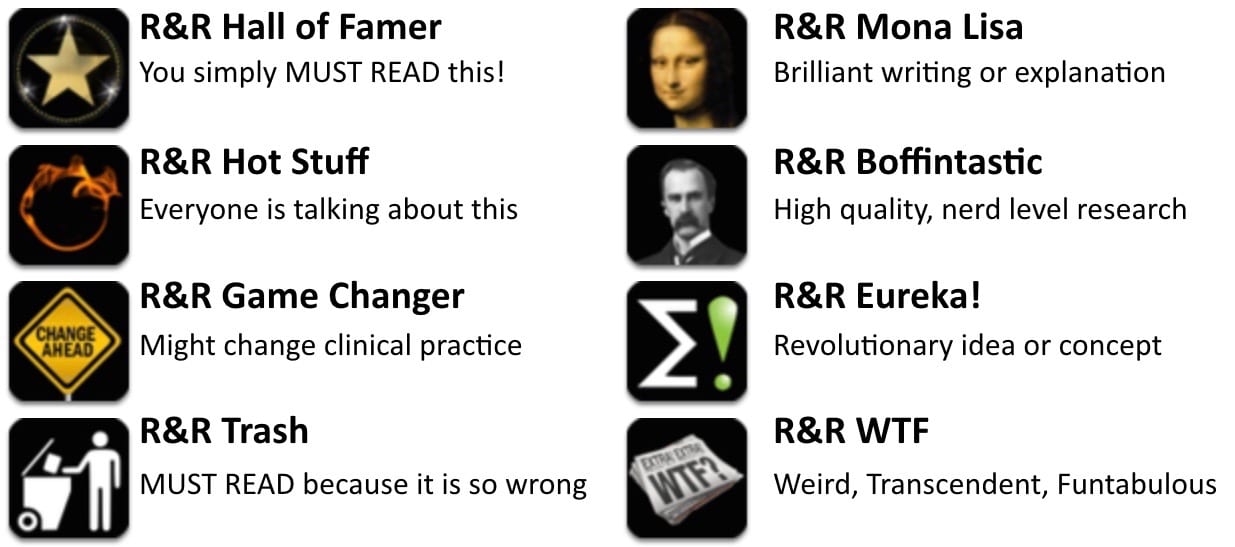R&R In The FASTLANE 128
Welcome to the 128th edition of Research and Reviews in the Fastlane. R&R in the Fastlane is a free resource that harnesses the power of social media to allow some of the best and brightest emergency medicine and critical care clinicians from all over the world tell us what they think is worth reading from the published literature.
This edition contains 6 recommended reads. The R&R Editorial Team includes Jeremy Fried, Nudrat Rashid, Soren Rudolph, Anand Swaminathan and, of course, Chris Nickson. Find more R&R in the Fastlane reviews in the : Overview; Archives and Contributors
This Edition’s R&R Hall of Famer
Vavalle JP, et al. Effect of the Presence and Type of Angina on Cardiovascular Events in Patients Without Known Coronary Artery Disease Referred for Elective Coronary Angiography. JAMA Cardiol. Published online March 16, 2016. doi:10.1001/jamacardio.2016.0076.
- In this short research letter we find further lack of utility for stress tests in the manner for which we are currently using them for risk stratification. The authors categorized patients referred for catheterization without known CAD to groups based on chest pain symptoms of: typical, atypical, or absent. They then looked at their stress test results, categorized as positive or negative, and found that a negative stress test did not help predict those without obstructive CAD on catheterization. Specifically, patients with typical angina symptoms and a negative stress test were the MOST likely to have obstructive CAD (74%). Clearly limited by the nature of the data presented, and the limited information given regarding the methodology in this research letter, it does further raise doubts regarding the utility of stress testing to risk stratify patients for CAD.
- Recommended by: Jeremy Fried
Weekes AJ et al. Diagnostic Accuracy of Right Ventricular Dysfunction Markers in Normotensive Emergency Department Patients With Acute Pulmonary Embolism. Ann Emerge Med 2016. PMID: 26973178
- RV dysfunction in patients with pulmonary embolism appears to portend worse long-term outcomes in normotensive, non-shock patients. Early identification may prompt physicians to consider the administration of thrombolytic agents. While biomarkers are often used (Troponin, BNP) echocardiography is a superior diagnostic modality. This study looks at the accuracy of Emergency Physicians (EPs) in using POCUS to diagnose RV dysfunction. The small group of highly trained EPs were able to reliably identify RV issues with a (+) LR = 90 and a (-) LR of 0. While this looks great, it’s important to note the high level of training and the small number of patients (26) with RV dysfunction. More work needs to be done on how this applies to the typical EP.
- Recommended by: Anand Swaminathan
Mosier JM et al. The Physiologically Difficult Airway. W J Emerg Med 2016. PMID: 26759664
- This article reviews patient features portending a physiologically difficult airway including hypotension, hypoxia, severe metabolic acidosis and RV failure. Additionally, the authors give recommendations on how to address these abnormalities prior to intubation. This article is really more defense of the “new RSI” – resuscitation sequence intubation and is a must read for anyone intubating sick patients.
- Recommended by: Anand Swaminathan
- Further reading: The Physiologically Difficult Airway-Part 1 (Pulm CCM)
Smith SB, et al. Analysis of National Trends in Admissions for Pulmonary Embolism. Chest 2016. PMID: 26905364
- Another article that demonstrates we are picking up more and more patients with pulmonary embolism (PE) but probably picking up those with less severe disease. This national database mining expedition found a 237% increase in hospital admissions for PE between 1993 and 2012 (23/100,000 to 62/100,000). Mortality and admission rates for massive PE declined during this same time period, suggesting we are detecting more PEs that may have variable clinical implications. . The 2016 ACCP VTE guidelines push for outpatient management in select patients with PEs, reinforcing that hospitalization, while very common, may not be necessary or beneficial for all PE patients.
- Recommended by: Lauren Westafer
Beres AL, et al. Comparative outcome analysis of the management of pediatric intussusception with or without surgical admission. J Pediatr Surg 2014. PMID: 24851762
- Intussusception is commonly encountered and is rewarding to treat effectively! The question is, though, after you have successfully reduced the problem, does the child need to stay in the hospital for observation? We know that intussusception can recur, so it seems reasonable, but does that hospitalization influence the recurrence rate or complications? In short, no. There is evidence that stable, afebrile, children who have a reassuring exam and can tolerate oral fluids are safe to be discharged from the ED. Sound crazy? Check it out.
- Recommended by: Sean Fox
- Further reading: Intussusception Discharge (Pediatric EM Morsels)
Maddow CL, et al. Efficient communication: assessment-oriented oral case presentation. Acad Emerg Med 2003. PMID: 12896884.
- Nice little study on “assessment-oriented case presentations.” Briefly, give the answer first. Especially when talking to consultants (definitely with surgeons) rather than rambling on with a mystery story. COI: the first auther is married to my sister, and the last author’s office is adjacent to mine.
- Recommended by Seth Trueger
Emergency physician with interest in education and knowledge translation. #FOAMed Fan | @jdfried |







Pain management in patients with renal colic. Good read! possible game changer?
http://www.thelancet.com/journals/lancet/article/PIIS0140-6736%2816%2900652-8/abstract